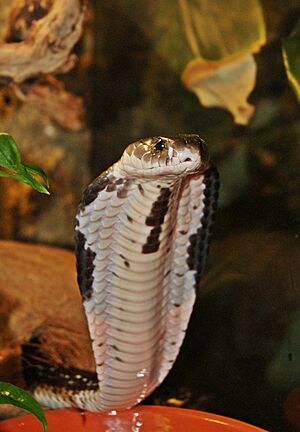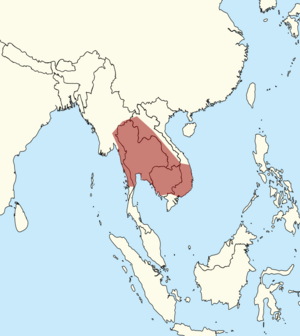Indochinese spitting cobra facts for kids
Quick facts for kids Indochinese spitting cobra |
|
|---|---|
 |
|
| Conservation status | |
| Scientific classification | |
| Genus: |
Naja
|
| Species: |
siamensis
|
 |
|
| Naja siamensis distribution | |
The Indochinese spitting cobra (Naja siamensis) (Thai: งูเห่า, pronounced: nguu hao), also called the Thai spitting cobra, is a type of spitting cobra found in Southeast Asia. This snake is known for its unique way of defending itself by "spitting" venom.
Contents
About the Indochinese Spitting Cobra
This cobra is a medium-sized snake. It has a more slender body compared to many other cobras. Its body color can change a lot. It might be grey, brown, or black. It often has white spots or stripes. Sometimes, the white patterns cover most of the snake's body.
In central Thailand, these snakes are often black and white. Snakes from western Thailand are mostly black. Those from other areas are usually brown. The mark on its hood, which is the flattened part behind its head, can look like spectacles. Sometimes it's an odd shape, or it might not be there at all, especially in older snakes.
Adult cobras are usually about 0.9 to 1.2 meters (3 to 4 feet) long. Some can grow up to 1.6 meters (5.2 feet), but this is rare. An adult snake usually weighs around 1,600 grams (3.5 pounds).
This cobra can be confused with the monocled cobra (Naja kaouthia). They live in similar places and look alike. A key difference is how the Indochinese spitting cobra spits venom. Instead of a strong stream, it often sprays a fine "mist" of venom. Its spitting range is usually about 1 meter (3.3 feet). However, some reports suggest it can spit up to 2 meters (6.6 feet) in a stream.
Snake Family Tree
The Naja siamensis snake belongs to the Naja genus. This genus is part of the family called Elapidae. The Austrian-born Italian zoologist Josephus Nicolaus Laurenti first described this snake in 1768.
The name Naja comes from a Sanskrit word, nāgá, which means "cobra." The second part of its name, siamensis, comes from "Siam." This is an old name for Thailand. So, siamensis means "from or relating to Thailand."
For a long time, people confused this snake with the monocled cobra (Naja kaouthia) and the Chinese cobra (Naja atra). This was because their patterns and scales varied a lot. But in the 1990s, detailed studies showed that Naja siamensis is its own unique species.
Where They Live and Their Homes
You can find the Indochinese spitting cobra in Southeast Asia. This includes countries like Thailand, Cambodia, Vietnam, and Laos. It might also live in eastern Myanmar, but there are no official records. Some have even been found in Taiwan. They were released there because of old Buddhist traditions.
These snakes live in many different places. They can be found in lowlands, hills, plains, and woodlands. They also live in jungles. Sometimes, they come close to human homes. This is because there are often many rodents (like mice and rats) living around people. Rodents are a good food source for the cobras.
Behavior and Diet
The Indochinese spitting cobra is mostly active at night. Its behavior can change depending on when you meet it. If it feels threatened during the day, it's usually shy. It will try to hide in the closest burrow or hole.
However, if you threaten it at night, it becomes more aggressive. It is more likely to stand its ground. It will raise its body, spread its hood, and spit venom. If spitting doesn't work, it will strike and bite as a last choice. When it bites, this snake tends to hold on and chew. This makes the bite more serious.
These cobras usually eat rodents, toads, and other snakes.
Reproduction and Life Cycle
The Indochinese spitting cobra lays eggs. This means it is an oviparous animal. After the female lays her eggs, it takes about 100 days for them to be ready. She will lay between 13 and 19 eggs.
The eggs will hatch after 48 to 70 days. The exact time depends on the temperature where they are kept. Once the baby snakes hatch, they are ready to live on their own. They don't need their mother's help.
Hatchlings are usually 12 to 20 centimeters (about 5 to 8 inches) long. Some can be as long as 32 centimeters (about 12.5 inches). Even though they are small, baby cobras have fully working venom systems. This means they are just as dangerous as adult snakes and should be treated with great care.
Venom and Safety
Like most other spitting cobras, the venom of the Indochinese spitting cobra is very strong. It mainly contains two types of toxins. One is a neurotoxin, which affects the nervous system. This can cause paralysis. The other is a cytotoxin, which damages cells and tissues. This can lead to tissue death around the bite.
The strength of the venom can vary. This depends on things like what the snake eats and where it lives. If a person is bitten, they will feel pain and see swelling. Tissue damage, called necrosis, can also happen around the wound. A bite from this snake can be deadly for a human. Deaths usually happen because of paralysis, which makes it hard to breathe. This is more common in rural areas where it's hard to get antivenin, which is medicine to treat snakebites.
If the snake spits venom into someone's eyes, it causes immediate and severe pain. It can also lead to temporary or even permanent blindness. If this happens, it's important to wash the eyes thoroughly with water and seek medical help right away.
Images for kids



